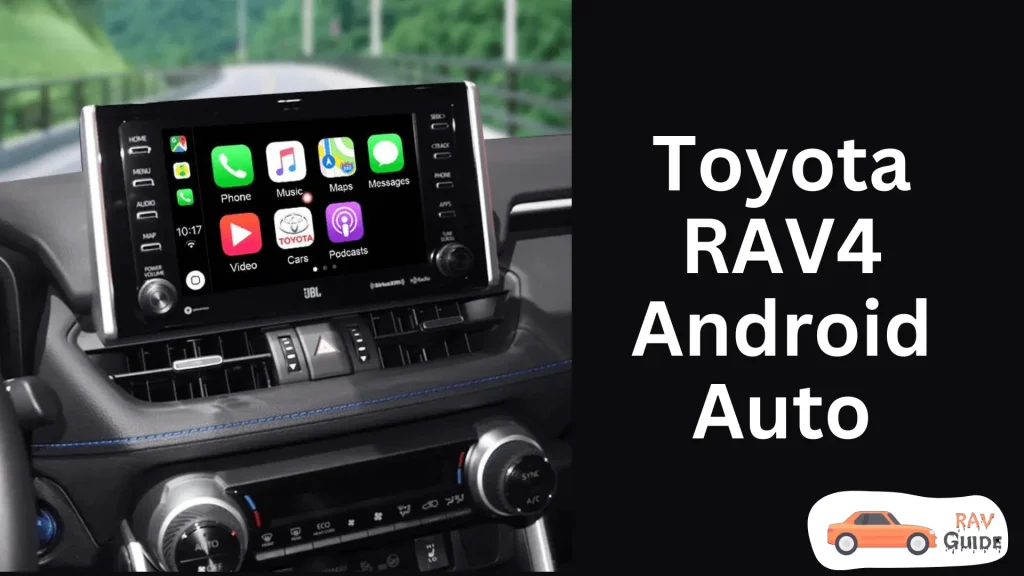Boosting your RAV4’s capabilities is crucial, and incorporating advanced tech features can make a big difference. One sought-after upgrade is wireless Android Auto, a cool feature that isn’t automatically available in every Toyota RAV4.
This guide not only explains the process of transforming to wireless Android Auto but also points out the specific adapter you need for the job. Additionally, I provide information on which RAV4 models already come equipped with wireless Android Auto as a standard feature. By following these tips, you can level up your RAV4 experience and enjoy the convenience of wireless connectivity on the go.
Toyota RAV4 Android Auto Overview
Let’s delve into the world of Android Auto, a smart technology that links up your compatible Android device with the RAV4’s head unit seamlessly, all thanks to wireless connectivity.
When you turn on your RAV4, your Android device automatically syncs up with the vehicle. Once connected, Android Auto brings a hands-free experience to the table, letting you harness the power of Google Assistant, navigate using maps, and manage your phone features effortlessly. It’s like having a tech-savvy co-pilot right in your car, making your drive not only connected but also safer and more convenient.
When Toyota RAV4 Android Auto Introduced?
Android Auto made its debut in the RAV4 back in 2020, bringing a new level of connectivity to the driving experience. In the 2020-2022 models of the Toyota RAV4, Android Auto is part of the package, but here’s the catch—it’s not wireless.
Fast forward to the 2023 model of the Toyota RAV4, and now, wireless Android Auto comes built-in as a standard feature. That means, if you own a 2023 RAV4, you don’t have to do anything special to enjoy the perks of wireless connectivity. It’s like having the latest tech right at your fingertips, making your driving adventures more convenient and enjoyable. You should also know about troubleshooting Toyota wind noise.
Model Availability
In the world of Toyota RAV4, starting from the year 2023 and beyond, every trim level comes with the fantastic feature of wireless Android Auto. You don’t need to worry about having to upgrade to a higher trim level just to enjoy this cool capability—it’s available across the board.
Now, if you happen to own an RAV4 from an earlier model year, say pre-2023, and you’re eyeing that wireless Android Auto goodness, fret not. While it might take a bit of tinkering, some modifications can make it possible for you too. Stick around, and I’ll guide you through the steps to bring wireless Android Auto to your older RAV4 model, so you can cruise with the latest tech features on board.
How to Convert Your Toyota RAV4?
Let’s talk about how to bring the magic of wireless Android Auto to your Toyota RAV4, even if it’s not a 2023 or newer model. Whether you drive a 2020-2022 RAV4 or an older 2013-2019 model, there are options available for you.
2020-2022 Toyota RAV4:
If you have a 2020-2022 RAV4, Android Auto is already in the mix, but it’s not wireless. The good news is, that with a wireless adapter, you can transform it into a wireless wonder. The adapter offers some neat benefits, like not needing a cable to connect your Android device, allowing your phone to stay in your purse or pocket, and ensuring an automatic connection without any hassle after the initial setup.
However, it’s essential to weigh the cons, such as a slight delay in connection each time and an additional cost for the adapter or an upgraded stereo system. Overall, the advantages often outweigh the drawbacks, making a wireless Android Auto adapter a sensible choice for many RAV4 owners.
2019 Toyota RAV4:
The 2019 RAV4 is a bit peculiar—it includes Apple CarPlay but doesn’t come with Android Auto. To bring Android Auto into the mix, you’ll need to swap out the multimedia center, similar to older RAV4 models.
2013-2018 Toyota RAV4:
For those driving a 2018 or older RAV4, an adapter won’t cut it because Android Auto isn’t part of the package. To enhance your capabilities, the only solution is to upgrade to an aftermarket stereo system. With a plethora of options available, choosing the right one can be a challenge.
While there are budget-friendly choices, they may compromise on quality and features. It’s essential to strike a balance between cost and performance when selecting an aftermarket stereo for your RAV4.
Conclusion
In the world of Toyota RAV4, whether you own a 2023 or newer model with built-in wireless Android Auto or an older one, there’s a way to level up your driving experience. With the right wireless adapter or an upgraded stereo system, you can seamlessly connect your Android device, enjoying the convenience of hands-free features. While it may involve some tweaks, the payoff of a more connected and enjoyable ride makes the effort worthwhile, allowing every RAV4 owner to stay ahead in the tech game on the road.

